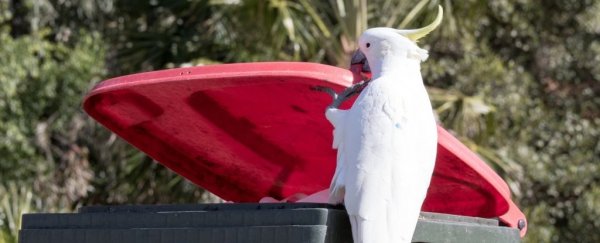Australia's sulphur-crested cockatoos have rapidly turned into big city birds.
In Sydney, these large, white, and noisy parrots (Cacatua galerita) have fully adapted to the urban environment, quenching their thirst in public drinking fountains and foraging for food on the streets.
Some have even learned how to throw open the lids of trash bins to comb through the wastage for scraps. Now, researchers have noticed this phenomenon spreading across dozens of new suburbs in Sydney, and the reason could be down to cultural learning amongst the birds.
 A cockatoo opening a bin while another watches. (Barbara Klump/Max Planck Institute of Animal Behavior)
A cockatoo opening a bin while another watches. (Barbara Klump/Max Planck Institute of Animal Behavior)
Even when residents weigh down the tops of their bins with bricks or stones, cockatoos have figured out how to knock these heavy objects to the ground.
Once that barrier is removed, the hungry birds can crack the lid open with their beak, prop it on their heads and walk it back until it fully flips on its hinges, as the videos show below.
This unique skill has now become so widespread in Sydney, researchers think the parrots are imitating and learning from one another - a sign of cultural evolution.
The suspicion is based on hundreds of observations from city residents. The research team, led by biologist Barbara Klump from Max Planck Institute of Animal Behavior in Germany, gathered 1,396 reports from residents across 478 Sydney suburbs, asking about cockatoo bin-opening behavior. A total of 338 bin-looting incidents were reported.
Before 2018, the results show these bin-opening skills of cockatoos were confined to just three suburbs of Sydney, each separated by quite a lot of distance. Yet after 2019, the technique had rippled out to 41 surrounding neighborhoods as well.
That's a rapid spread in a very short period of time, and researchers think it's due to birds culturally learning and adopting the technique.
Yet not all the cockatoos tackled the trash bins in the exact same way. In the far north of Sydney, for instance, cockatoos might be more likely to walk around the right side of the bin while holding the lid, while in the center of the city, these birds might shimmy or hop with the lid on their head.
It probably depends on whom the birds were imitating when they first learned the skill.
"Our results show that the spread of innovation can not only result in establishment of culture, but can also further lead to emergent geographically distinct subcultures," the authors write.
Identifying animal cultures and their spread is challenging science, and little research to date has studied the learned culture of large parrots, despite the fact these birds are highly social and possess really clever brains.
In fact, some bird experts argue cockatoos are just as smart as chimpanzees, who also show evidence of social learning and cultural transmission.
Some populations of chimpanzees, for instance, have adopted a unique culture of honey digging. Through imitation and social learning, these primates have figured out how to use sticks to pull sticky sweetness from logs on the forest floor.
Cockatoos are similarly innovative, even when in the big city, far from their natural wooded habitats. Marking cockatoos at one of the original trash-diving sites, researchers noticed large male parrots are usually the ones throwing open the lid with the most success.
Older and more experienced cockatoos were also seen chucking youngsters out of the way, forcing them to merely watch instead.
 Cockatoos watching one of their own. (Barbara Klump/Max Planck Institute of Animal Behavior)
Cockatoos watching one of their own. (Barbara Klump/Max Planck Institute of Animal Behavior)
In fact, more than 90 percent of the time, when Sydneysiders noticed a cockatoo opening up their bin, there were multiple birds standing around, watching the attempt. Such close observation is a prime opportunity to pass on a skill via social learning.
"Although directionality cannot be ascertained from these data, these patterns are consistent with those expected from social learning," the authors write, "with associated and more socially central individuals having better access to social information and therefore a greater likelihood of learning."
If the authors are right, and this culture of bin-opening is really spreading from three main hotspots in Sydney, more suburbs are in for an inevitable bird surprise. Perhaps, like in raccoon-dominated Toronto, city councils will need to come up with new bin designs.
The study was published in Science.
